In this article we will explain what a Digital Transformation Strategy is and the steps you can put in place to make your business processes run as efficiently as possible.
Whether you’re looking to go paperless, to understand which technology is the right fit for your organisation or how to create automated workflows, DocTech is here to help.
If you think digital transformation seems a little scary and don’t know where to start, or that it’s just a buzz phase and something you can ignore, we hope to help explain that it’s neither.
Digital is most definitely here to stay and we know how aware business leaders are. We recognise there’s a reluctance to get started for a whole variety of reasons and we understand that changing how you operate can seem daunting.
If business processes are out dated or underperforming and causing problems for staff, customers and the bottom line then it’s time to change.
If you’re not doing it your competitors will be.
Don't have time to read this full guide? Download it for free now! 👇
Digital Transformation is a phrase that’s been around for a while now but what is it? Many organisations that feel it’s something they should be embracing may still be unsure of what it really means and where to start.
Digital Transformation is about understanding how technology and its integration can transform business processes, employee engagement and customer experience to meet the demand of your market.
If your organisation has made the move from paper records and binders to digital computer files, then you have digitised. It’s a great initial step towards Digital Transformation but in order to completely embrace the concept, you have to go further.
Digital information can be shared more easily than it was before and it’s bound to be more efficient that it was. But if you have just recreated your paper filing structure in a computer folder, you’ve missed the key to digital transformation.
A Digital Transformation Strategy is about taking a technology first approach to your processes. Seeing what technology can offer and then finding the right solutions to fit your values and business model.
Your business data may now be digital but having a good strategy in place is about doing the right things with that data. Using it to make processes and operations run smoothly to avoid extra effort and wasted time.
Having a Digital Transformation Strategy in place isn’t all about changing how you do business, but about improving processes – making them quicker and slicker.
Information that’s trapped on paper can be inaccessible or lost, slowing down production and leading to poor customer service.
Becoming a paperless office can seem like a huge task, but slowly making the move from paper files to digital ones will make the transition much easier, one department or process at a time.
There has been a huge shift in the way we all think about recycling and what we can do to reduce our waste at home. In 2020, recycling increased across the UK with 89% of people saying they regularly recycle and 56% saying they are recycling more in the past year.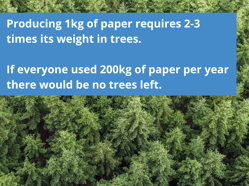
If we’re all doing more at home, why not in the office too?
Worldwide, 4 billion trees are cut down every year for paper. That’s one per cent of the Amazon Rainforest – every single year.
When we talk about ‘a paperless office’ the goal should be to reduce unnecessary printing and to digitise paper documents as soon as they arrive in the business. This means they’re less likely to be lost or damaged and make processes quicker and more accurate.
The announcement of the Electronic Trade Documents Bill that ends the need for paper based trading documents will mean a huge reduction in global paper use, as well huge savings for businesses.
Paperless trading will mean that UK businesses trading internationally can for the first time keep all their documentation electronically. Read more about how it may benefit your business and the environment in our blog - Paperless Trade and The Electronic Trade Documents Bill.
Before changing any paper files into digital ones, organisations should think about what documents are used regularly and which will provide the greatest benefit of being in digital format. Is there a department that processes more paper than another and starting there would be more beneficial?
If you no longer access documents in archive, leave them where they are until it’s time for them to be destroyed. If however you’re often having to bring files out of storage then it makes sense to back scan this information into digital files that are much easier to access. Read more about how one of our Finance Services clients Wettone Matthews did just this.
Scanning your incoming post along with asking suppliers to send invoices via email are quick ways to reduce your paper usage and work towards a paperless office. Once documents are in digital format there is little value in storing them in network folders that can replicate the same problems you had with physical paper.
Data capture software ensures all documents entering the business are captured accurately whether that's invoices, application forms or delivery notes.
Information on them is extracted, stored in our document management software and then pushed to any third party application such as Sage, SAP or Dynamix Nav.
This avoids the errors associated with manual data entry and saves a huge amount of time as tedious tasks are removed.
DocTech provide dedicated document scanners via our elite partnership with Kodak Alaris.  A variety of scanners are available from small and quiet options ideal for reception areas, through to large scale scanning requirements capturing 140 pages per minute. As an Elite Partner with years of experience in document scanning, we also receive scanner discounts we pass on to our customers. Read our blog - Your Guide To Buying Business Scanners which will take you through the options available.
A variety of scanners are available from small and quiet options ideal for reception areas, through to large scale scanning requirements capturing 140 pages per minute. As an Elite Partner with years of experience in document scanning, we also receive scanner discounts we pass on to our customers. Read our blog - Your Guide To Buying Business Scanners which will take you through the options available.
Misfiling, loss, duplication and issues around version control are all still common concerns with digital files that aren’t stored in the most efficient way possible. 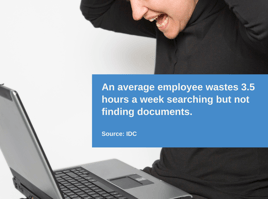 A cloud document management system eradicates all these problems by storing your digital documents in one central and secure location.
A cloud document management system eradicates all these problems by storing your digital documents in one central and secure location.
Documents enter the document management sSystem via a connected scanner, automatically from an email via an integrated inbox or can be dragged and dropped in.
They are stored using strict naming conventions – a delivery note can only be stored under that name, no other variation such as ‘goods received note’ or ‘dispatch note’ can be used.
Once in the document management system, documents are easily retrieved and can become a part of any process or document workflow your organisation requires.
For many organisations, managing employee expenses is challenging. It takes longer than it should, the process is laborious and error prone and Finance are often left chasing staff to submit their receipts. Employees have to keep on top of paper forms and spreadsheets and receipts mount up.
Organisations with paper based or manual processes are missing out on the time and cost savings a digital expense management system offers.
With such a solution, all information is captured centrally and input by the employee, removing spreadsheets and paper forms.
Receipts can be photographed via a mobile and uploaded into the system, meaning paper copies no longer have to be held onto for weeks until it's time to submit them.
Read our tips on moving from a paper based process to a digital workflow.
When global leaders instructed their employees to work from home during the COVID Pandemic, any organisation that previously completed processes by passing paper around their building, sadly ground to a halt.
Departments who were reliant on banks of filing cabinets were unable to function.
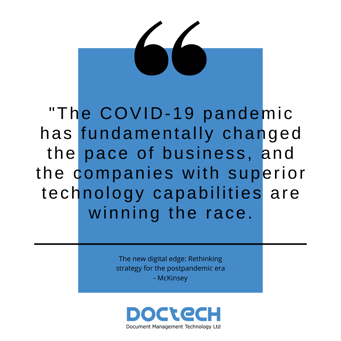
With the mad scramble that followed the global lockdown in March 2020, many organisations rushed to put in place the quickest and cheapest cloud based document storage solutions they could find.
True, these can be described as digital solutions but they are not a Digital Strategy.
For a true Digital Transformation Strategy you need to look at your processes through a new lens and be open to the possibilities that technology can offer.
Numerous business processes only function the way they do because of the limitations of manual and paper based systems. Once you break down those barriers you can discover the efficiencies and advantages to using a digital system.
Throwing a load of tech at employees or trying to shoe-horn software into your
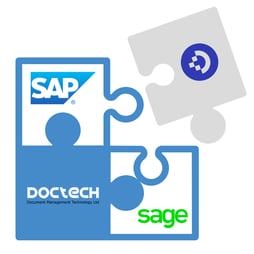 existing processes won’t work. Whatever digital solutions you decide to use, they’ve got to be fit for purpose and not just following the latest trend.
existing processes won’t work. Whatever digital solutions you decide to use, they’ve got to be fit for purpose and not just following the latest trend.
Technology is the tool you’ll use as a part of your digital transformation strategy. It will aid process improvement and in turn enhance customer service.
Think about how it will integrate into your existing IT environment as choosing technologies that speak to each other is vital for any long term digital strategy.
Many organisations have a piece of software for every aspect of their business but if they don’t integrate with one another, how can you improve efficiency?
What are the Strengths, Weaknesses,.png?width=271&name=SWOT%20(1080%20x%20500%20px).png) Opportunities and Threats of your current processes? Doing this assessment will provide the starting point for your Digital Transformation Strategy and will show you the areas technology can help build on or improve.
Opportunities and Threats of your current processes? Doing this assessment will provide the starting point for your Digital Transformation Strategy and will show you the areas technology can help build on or improve.
You’ll be able to understand what your company does now, where you’d like to be in the future and what needs to happen to get there.
After the SWOT analysis is complete you should have an idea of next steps. In order to put these in place you need to think about who’s going to be involved. It is people and their skills that will drive your Digital Transformation Strategy forward so including them and having their buy in is vital.
Any technology implemented needs to be user friendly otherwise it will not be easily adopted and plans of change can grind to a halt.
You may have identified multiple processes that need improvement but trying to tackle everything at once will be difficult.
Take the process that causes the most problems and work through that one first.
There's more reading in our blog - 6 Tips for Implementing Digital Transformation Software.
Mapping processes is the effective way to visually describe the flow of work from the beginning to the end of any business process. It is a step by step guide that helps everyone across the business understand all the moving parts.
In our experience documents are often at the heart of any business process, whether it’s an invoice in a Finance process or a CV kick starting a HR process. The movement of these documents around the business, and how they are dealt with is that we are most concerned with.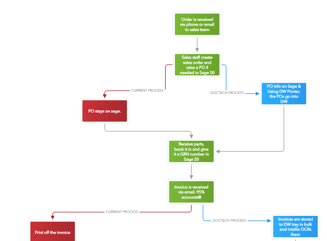
Every document has a journey and when it arrives in a business its movements are governed by internal processes and rules. Sometimes these rules aren’t followed or understood by staff which is when problems occur. Documents may go missing, employees don’t have the right information available to do their jobs, orders could be missed or invoices paid late.
By understanding an organisations’ current processes we can also understand the challenges they face. We can then help them map out the desired processes in a clear and concise way.
At DocTech we have come across a variety of processes working with organisations of all sizes and across multiple industries. We’ve picked up some best practise ideas along the way and want to share them so you can gain the benefits of mapping out your processes.
We often hear people say things like “the order arrives” or “we input it into the system”. How does the order arrive? In what format? Try to explain your processes in a way that someone who has no knowledge of your business would understand.
Use Process Mapping as an opportunity to review why your processes are the way they are, and if they’re still working as well as they should be.
When moving from paper processes to digital ones, sometimes habit causes people to keep things the same. Don’t just transfer an old fashioned paper workflow to a digital system and bring all those problems along with it.

When errors happen in the business the tendency is to add another rule to create a feeling of safety. Maybe a second person needs to check a test result? Or a senior manager needs to approve a purchase?
Often these checks create delays and bottlenecks in the process. When creating your Process Map think about how many of these steps you actually need. Human error is inevitable and so bear in mind a digital system that reduces manual work will also reduce these errors.
Before you remove a step ask yourself “I don’t need to do this but does someone else need to know it?” Something might seem irrelevant and disposable to you but that piece of information is vital for someone else to complete their job.
Pictures speak a thousand words. Trying to explain your process in sentences can be very confusing, especially when there are multiple possible outcomes from a certain situation.
At DocTech we use a process planner which creates a flow chart of our client’s existing process and then the new process we intend to implement.
This gives a clear visual representation of the intended improvement which all parties can clearly understand. It also means that people coming into the process late can easily see what has been agreed.
If you'd like to chat with us about mapping your processes then please, get in touch.
Any disruption to a business process will cost your organisation time and money and depending on severity, it could also have a detrimental effect on customers too. This is why seeking out bottlenecks and putting actions in place to avoid them should be high on the priority list.
The term ‘bottleneck’ of course refers to the narrowest part of a bottle where it’s most like any congestion will occur, slowing down the flow of its contents when poured.
A bottleneck in a business process could start when an increase in sales creates extra work that current process can’t handle. An influx of orders could mean more raw materials are needed, more invoices need to be processed and more deliveries need to be tracked. This could all create delays in production, added stress for employees and disruption to the customer who’s expectations may no longer be met.
Bottlenecks can occur for a variety of reasons. Organisations that are client heavy or that deal with high volumes of sales, often have a huge problem in handling the large number of incoming documents they need to make processes work.
If there are long waiting times during any part of the process, for example a product to be made or a report produced then you could have a bottleneck.
Too much work piles up at one end but not enough at the other. Plenty of orders are being placed but because of slow invoice processing, payment confirmations are delayed therefore products aren’t shipped.
If tensions are running high amongst staff, it could be because they’ve got too much on, or can’t complete their work as they’re waiting on someone else.
Finding the cause of the process bottlenecks can be tricky but looking at common situations that arise or staff who are often stressed will be good indicators. For more information you can also read our blog on The Top 4 Process Bottlenecks and How to Avoid them.
A document management system provides a digital way of storing, managing and searching for documents. With a system in place, documents are secure and easily accessible to anyone with authorised access. The system can cope when document volumes and associated processes increase.
When important information is lost amongst paperwork or trapped in email inboxes, the time spent looking for it may seem insignificant but if it’s a regular occurrence, this time mounts up and starts to cause problems.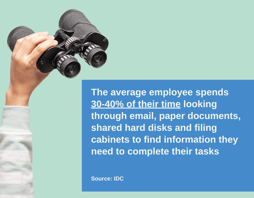
If the document was lost, how valuable was the information in it and how would you go about finding it again? What else could employees be doing instead of searching for documents?
How a document management system will help
Once in the system, documents cannot be lost because they are securely saved and tagged with metadata. This information becomes what the document is stored against – document type, year, client, employee etc.
A search of ‘2021’ will bring back results for any document stored in that year. Add document type of ‘contract’ to that search and all contracts stored in 2021 will be found in seconds.
Some employees are struggling to keep up with the demand of their workload while others are struggling to keep themselves busy. This is an inefficient use of resources and can lead to resentment in your team.
Overworked employees make errors, especially when working on manual data entry.
How a document management system will help
Tasks can be assigned to team members automatically by the system based on their role or workload. When a CV is received into the document management system, a HR Manager and Line Manager can be notified by email it’s waiting to be reviewed. If the system sees the HR manager already has 10 tasks that aren’t complete, it can notify the HR Assistant instead.
This is all done based on your business rules and requirements which are agreed upon during implementation of the solution.
Manual data entry can also be reduced as scanned documents can be read by the system with the information saved, then pushed into another – if required.
When processes are geographically restricted to an office or to office based servers, workflows come to a halt when people leave the office. As we saw with lockdowns in place during the Covid Pandemic, this reliance on office based processes leaves business inflexible to changing demands.
How a document management system will help
Information stored in a document management system can be accessed from anywhere with an internet connection and on any device. It is perfectly suited for working from home or being out on the road, making access to business information simple.
If you’re a Project Manager on site and need all the latest designs, product specs or scopes at your fingertips, there’s no longer a need to carry all these documents with you. Not only does this waste paper but it means documents could be easily lost or damaged.
The latest version of all these documents can be viewed and updated from a mobile or tablet meaning admin work can still be completed when away from the office.
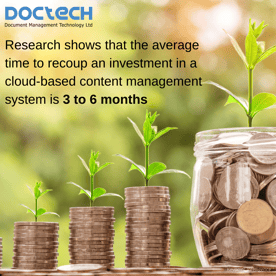
Working in the Cloud offers organisations flexible and scalable solutions that are able to cope under pressure. A cloud document management system doesn’t rely on a company’s servers or IT team. Physical assets like servers, routers and hard drives no longer need to be bought, maintained or upgraded.
Instead, users can access files and applications from almost anywhere and on device as the storage takes place on servers in an external data centre. Enabling employee’s easy access to the information they need to do their job means they are no longer bound by four office walls.
Here we discuss the five Benefits of a Cloud Document Management System that will support any organisation with their Digital Transformation Strategy.
By using the cloud, multiple users can share information and resources without compromising on security. With our document management system, documents and data are protected using a high security data centre in the US and Europe. Everything is stored with Advanced Encryption Standard (AES) which is a military level protection, alongside data traffic taking place via HTTPS with TLS encryption. This prevents critical data such as passwords and financial information from being captured.
Flexibility is important to all businesses. As the Covid Pandemic has shown, unexpected events can mean businesses need to rapidly scale up or down in response to events. An increase in user numbers or traffic volume are easy to accommodate in cloud based platforms as additional server functionality is automatically provided.
With Cloud document management, a full range of services are included meaning you get all the bells and whistles from the get go. As your company grows and requires more enhanced features, the system grows with you.
Flexible licenses and storage capacity are available for different company sizes and organisational needs.
A Cloud Document Management System from DocTech means we will be responsible for any upgrades and support needs. We have a team of in-house experts to look at any issues and help with training needs.
The solution can be quickly up and running without lengthy IT processes. Once we understand your requirements and the Scope of Works is agreed, deployment can be done in days.
Automating a business process is a way of removing manual and labour intensive work and allowing technology to carry out this tedious work in the background.
Automated business processes should be a part of any successful Digital Transformation Strategy, and implementing cloud software is the perfect way to get started.
A cloud document management system goes hand in hand to support the automation of any document centric workflow. Whether that’s invoice processing, contract management, employee on-boarding, purchase order requisition or delivery note management.
Data from any document can be automatically extracted by the software. This information is then used as the categories to store the document against and subsequently search on. Not only that, but the information can then be pushed via an integration into any third party system such an ERP or Finance Package.
This removes manual data entry and associated human error and speeds up processes, creating a document workflow that is specifically designed for your organisation.
A digital signature solution is a much quicker and efficient way of obtaining signatures no matter what the document type – Non-Disclosure Agreements, Contracts, Employee Agreements, Meeting Minutes etc.
If your organisation is still signing documents manually then it’s likely your processes are slow, inconvenient and costly. How much time do you spend tracking down the status of a document or repeatedly chasing for it to be signed?
Digital signature software is a great addition to any Digital Transformation Strategy as it means there is no paper, printing or physical storage of the completed document required.
If you’re automating office processes then digital signatures are simple to include and with a Document Management System in place, the signed document can automatically be securely stored away.
Yes! Digital signatures are legally binding and in the UK they have been legally recognised since 2002. The digital signature software we provide complies with eIDAS Regulations, and with the European standards ISO 9001 and ISO 27001 for quality management systems and the handling of sensitive data.
The benefits of digital signatures are becoming more and more apparent to businesses looking to streamline operations.
A digital signature makes it fast and simple to sign agreements and contracts with the convenience of being able to do it from anywhere. Our digital signature solution can be used in both face-to-face and remote situations and so works perfectly with the hybrid working patterns we now all find ourselves in.
Our digital signature software can be integrated into a wide variety of systems including Document Management Systems, ERPs, Sage, Office 365 and more.
Integration with a Document Management System provides the perfect way to share, approve, send and receive documents that need to be signed.
To ensure security of remote signatures the digital signature solution requires two factor authentication when obtaining a signature. This is done via email and a One Time Password (OTP) is sent to the signer's smartphone with which they can secure their identity.
For a biometric signature, which is a handwritten electronic signature, evidence such as the speed and pressure of signing is performed on a tablet, with information collected which can uniquely identify the signer. For quality and legal certainty, signing cannot be done with a finger and requires a supported device.
Also, with no paper being involved, documentation cannot be lost or misplaced and when combined with our document management software. It is securely stored in the system.
With digital signature software you can reduce the number of steps it takes for a process to be completed. No emails back and forth, documents sent in the post or worse still journeys to an office to sign in person.
A hand written electronic signature on a tablet gives employees out on the road the ability to obtain a customer signature in situ, such as a work completion form for boiler repair. This signed document can be automatically uploaded into a document management system and available almost immediately for processing back at the office.
We hope that through our article we’ve given you enough information to make a start on your Digital Transformation Strategy. Putting plans in place to make a lasting change that will have a real impact on your organisation.
Understanding how to take the initial first step of moving from paper to digital, through to fully automated workflows that remove manual and tedious work from employees. Reducing stress and giving staff more time for meaningful work and to finally get to the bottom of that to do list!
Digital transformation won’t happen overnight but with our help, we want to make it a future goal that you can achieve.
DocTech have close to 40 years of experience in digital document management solutions that will remove document chaos from your organisation and replace it with structured and usable data.
Every industry from manufacturing to healthcare to retail are aware of the benefits of digital transformation and it’s likely that you’re competitors are already making the change to a digital way of working, if they haven’t already.
We want to help organisations on their digital transformation journey, whether it’s implementing digital signatures or going paperless.
During a free process assessment we will chat with you about your process challenges, where the bottlenecks are and the solutions we can put in place to ensure your business can meet the demands of your market.